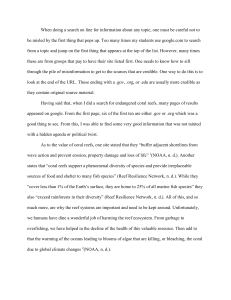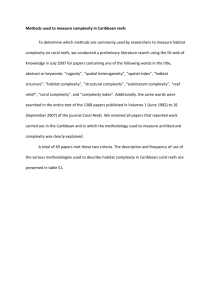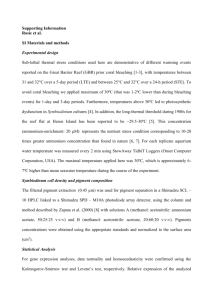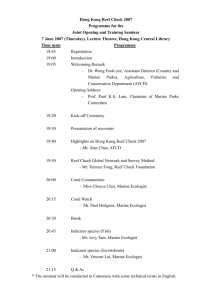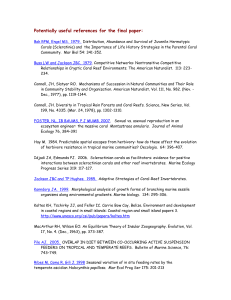Report of the CRCP Meeting - Gulf of Mexico Fishery Management
advertisement
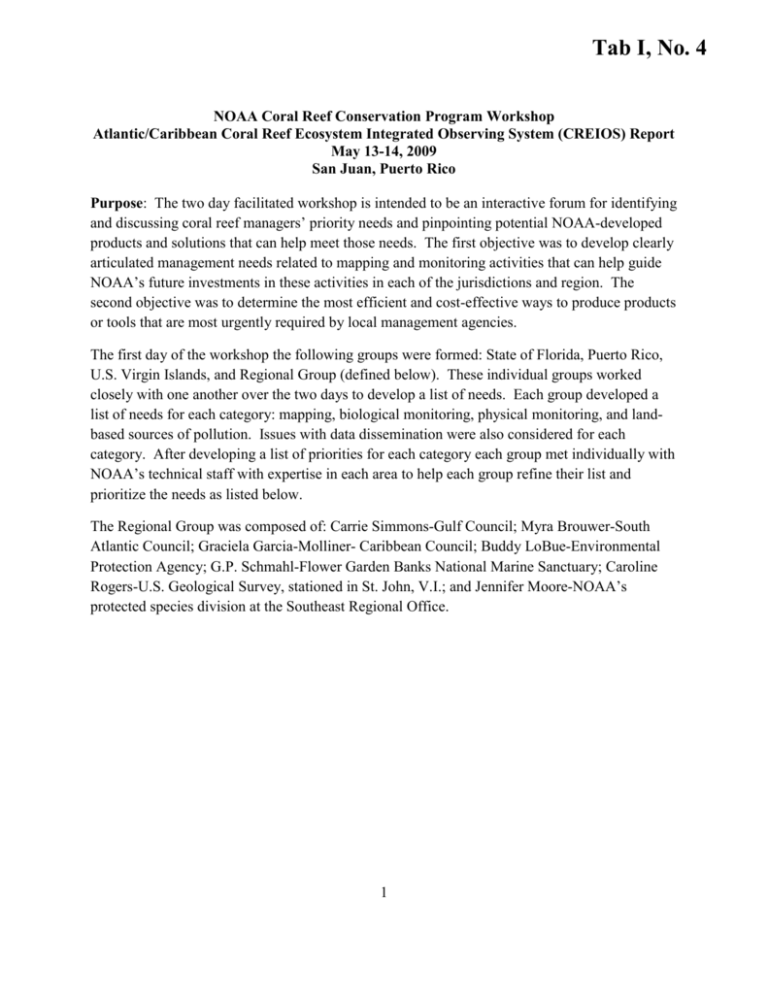
Tab I, No. 4 NOAA Coral Reef Conservation Program Workshop Atlantic/Caribbean Coral Reef Ecosystem Integrated Observing System (CREIOS) Report May 13-14, 2009 San Juan, Puerto Rico Purpose: The two day facilitated workshop is intended to be an interactive forum for identifying and discussing coral reef managers’ priority needs and pinpointing potential NOAA-developed products and solutions that can help meet those needs. The first objective was to develop clearly articulated management needs related to mapping and monitoring activities that can help guide NOAA’s future investments in these activities in each of the jurisdictions and region. The second objective was to determine the most efficient and cost-effective ways to produce products or tools that are most urgently required by local management agencies. The first day of the workshop the following groups were formed: State of Florida, Puerto Rico, U.S. Virgin Islands, and Regional Group (defined below). These individual groups worked closely with one another over the two days to develop a list of needs. Each group developed a list of needs for each category: mapping, biological monitoring, physical monitoring, and landbased sources of pollution. Issues with data dissemination were also considered for each category. After developing a list of priorities for each category each group met individually with NOAA’s technical staff with expertise in each area to help each group refine their list and prioritize the needs as listed below. The Regional Group was composed of: Carrie Simmons-Gulf Council; Myra Brouwer-South Atlantic Council; Graciela Garcia-Molliner- Caribbean Council; Buddy LoBue-Environmental Protection Agency; G.P. Schmahl-Flower Garden Banks National Marine Sanctuary; Caroline Rogers-U.S. Geological Survey, stationed in St. John, V.I.; and Jennifer Moore-NOAA’s protected species division at the Southeast Regional Office. 1 Priority Lists Developed by the Regional Group - The bolded items are considered higher priority by the group. List of Mapping Priorities A. Bathymetry for unmapped areas-Gulf of Mexico and U.S. Caribbean. Afterward determine areas of likely biological importance (via bathymetry, habitat, and models). B. Update benthic characterization in areas with outdated imagery. C. Finish mapping characterization in U.S. Virgin Islands Coral Reef National Marine Sanctuary. D. Map geo-reference sewage and industrial outflow areas of concern. E. Centralized data access-maps with bathymetry datasets from multiple sources. Biological Monitoring Priorities A. Track fish movement to better understand life history and habitat connections. B. Monitor Marine Protected Area effectiveness for Council closed areas and seasonally closed areas including the deeper Oculina bank reefs. C. Create standardized metrics and methods so data can be centralized and used by managers and other scientists. D. Determine if there is a correlation between 50% loss of live coral cover that occurred in 2005 and the effects on fish assemblages. E. Develop long-term adaptive monitoring. F. Create a co-location of biological, chemical, and physical parameters. G. Target opportunistic Acropora species monitoring. Physical Priorities A. Monitor water movement around reef areas with better flushing to determine if these areas are more resilient (e.g., bleaching and spread of diseases). B. Develop source/sink dynamics of existing Marine Protected Areas or Reserves (both fine and regional scale through instrumentation and satellites). C. Better data access to previous work (prioritize areas with gaps). 2 Land-Based Sources of Pollution Priorities A. Develop a model to predict pollutant-transport that is more applicable for tropical islands. B. Expansion of satellite monitoring to supplement nearshore models (e.g., chlorophyll, salinity, and sedimentation). C. Monitoring impacts of land based sources of pollution on habitat (attempt to tie those into applied research causality and biological monitoring). D. Co-location of biological, physical, and chemical parameter monitoring should be combined or placed in the same location with maps for better access in case of disasters. The specific monitoring and mapping needs identified by the jurisdictions will help the CRCP better balance the needs of local managers with those of the CRCP’s national program. It is expected that the information collected in advance of and during this workshop will be helpful in the jurisdictional priority setting processes that the CRCP is facilitating with Lighthouse Consulting. 3

